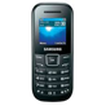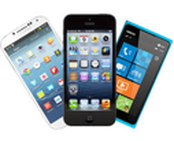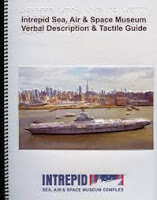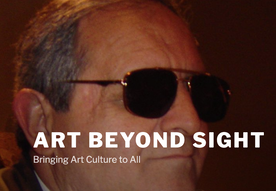Methods for Delivering AD

Sighted and blind museum-goers can listen to audio tours on venue-provided audio players, on cell phones, on smart phone and tablet apps, and on do-it-yourself solutions.
Audio Players
Major audio tour producers like Acoustiguide and Orpheo have a variety of players to sell or rent.
Some are audio only, some also contain screens to show images or play video. Blind visitors can easily use the players because navigation is via a touchpad just like a phone. Users enter a tour stop number and listen, with options for adjusting the volume and pausing or replaying the audio. This method of delivery requires a sighted companion or museum staff to tell the blind listeners the stop numbers to enter. Some museums choose to install infrared systems to automatically trigger audio stops, giving the blind visitor greater independence but less control over the listening experience.

Cell Phones
There are companies like Guide by Cell and OnCell that make it possible for sighted or blind visitors to use their own cell phones to dial a number and listen to audio tour stops. Listeners use their keypad to control volume and playback, and there is often a feature for leaving feedback for the museum on individual stops or the entire tour, like leaving a voicemail message. Companies who provide cell phone audio tours can produce and upload the audio for a museum, or provide the museum with software and instructions for doing it in house. This makes it easy for a museum to easily change the content of a tour if necessary.
A potential limit to cell phone audio tours is that some listeners prefer not to use their calling plan’s minutes, or do not want to use their phone’s battery life on a tour.
There are companies like Guide by Cell and OnCell that make it possible for sighted or blind visitors to use their own cell phones to dial a number and listen to audio tour stops. Listeners use their keypad to control volume and playback, and there is often a feature for leaving feedback for the museum on individual stops or the entire tour, like leaving a voicemail message. Companies who provide cell phone audio tours can produce and upload the audio for a museum, or provide the museum with software and instructions for doing it in house. This makes it easy for a museum to easily change the content of a tour if necessary.
A potential limit to cell phone audio tours is that some listeners prefer not to use their calling plan’s minutes, or do not want to use their phone’s battery life on a tour.

Smart Phone/Tablet Apps
There are a variety of companies that now produce museum tour applications for smart phones and tablets. Besides containing audio tours, these applications can contain still images and video, interactive features, links to web pages, and links to social media. People can download the app to their phone at the museum or before visiting.
These apps offer possibilities for designing tours that are accessible to multiple audiences. For blind visitors, the feature VoiceOver in iPhones and TalkBack in Android phones can make on screen text audible to people who are blind or have low vision. And for people who are deaf or hard of hearing, on screen transcriptions can make audio accessible. A potential limit to the use of apps is that visitors may not want to use up their phone’s data plan. A museum can solve that problem by providing wi-fi access within its walls.
There are a variety of companies that now produce museum tour applications for smart phones and tablets. Besides containing audio tours, these applications can contain still images and video, interactive features, links to web pages, and links to social media. People can download the app to their phone at the museum or before visiting.
These apps offer possibilities for designing tours that are accessible to multiple audiences. For blind visitors, the feature VoiceOver in iPhones and TalkBack in Android phones can make on screen text audible to people who are blind or have low vision. And for people who are deaf or hard of hearing, on screen transcriptions can make audio accessible. A potential limit to the use of apps is that visitors may not want to use up their phone’s data plan. A museum can solve that problem by providing wi-fi access within its walls.

Do-It-Yourself
Some smaller museums and presenting organizations have developed less expensive ways to provide audio tours for sighted and blind audiences. Some write their own audio description tour (or hire a writer) and then record the tour using inexpensive audio recording equipment, and computer editing software. Then they provide the audio to visitors on consumer quality playback products like CD players and iPods. A few museums have adapted blind audio labeling products like Pen Friend and Touch Memo to the museum setting.
Some smaller museums and presenting organizations have developed less expensive ways to provide audio tours for sighted and blind audiences. Some write their own audio description tour (or hire a writer) and then record the tour using inexpensive audio recording equipment, and computer editing software. Then they provide the audio to visitors on consumer quality playback products like CD players and iPods. A few museums have adapted blind audio labeling products like Pen Friend and Touch Memo to the museum setting.

A unique system (not do-it-yourself) that uses a pen is provided by TouchGraphics. The system uses a Talking Tactile Pen that can record and playback audio and that can trigger audio playback when it touches specially designed tactile images. The system was used to provide an audio description tour of the Intrepid Sea, Air, and Space Museum in New York. I wrote this tour in consultation with Art Beyond Sight. The pen has also been used in other museum exhibitions, including at the Boston Fine Arts Museum.

To Learn More
Art Beyond Sight offers a range of consulting services including how to use Audio Description in live settings during group tours with blind or visually impaired museum visitors. Here is a link for more about its Services
****************
Art Beyond Sight offers a range of consulting services including how to use Audio Description in live settings during group tours with blind or visually impaired museum visitors. Here is a link for more about its Services
****************